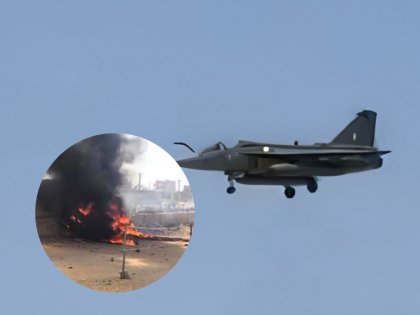SOURCE: RAUNAK KUNDE / NEWS BEAT / IDRW.ORG


The IAF’s first-ever LCA Tejas Mk-1 crash, which happened last year, has generated considerable discussion within the defense community. Although the initial narrative centered on a suspected oil pump malfunction leading to engine seizure, sources connected to idrw.org have now clarified that the oil pump was not the cause, reigniting attention on the incident and the true factors behind it.
The crash last year was a historic setback, being the first recorded loss of a Tejas aircraft since its induction. The jet, part of the IOC/FOC fleet, experienced engine failure while coming for landing after after taking part in a tri-services exercise, forcing the pilot to eject. While the pilot escaped unharmed, the incident prompted an immediate investigation by the IAF and raised concerns about the reliability of the aircraft, which is powered by the US-made GE Aerospace F404 engine.
Reports in the Hindustan Times first suggested an oil pump malfunction caused the Tejas Mk-1’s engine seizure. This was supported by the aircraft’s sudden engine failure and corroborated by videos capturing a distinct low whistle sound as the jet approached the airbase at low altitude, a clear sign of power loss. Nevertheless, idrw.org sources have clarified that the oil pump was not responsible. Instead, insiders indicate the pilot noted unusual engine noise soon after takeoff, signaling mechanical problems. Subsequent analysis has determined that inadequate oil levels, rather than a pump failure, were the main contributing factor.
“There was no oil pump malfunction,” a source told idrw.org. “Either the oil levels were lower than GE’s recommended standards, or there was a leak that went undetected before the flight.” This revelation shifts the focus from a mechanical defect to potential human error or oversight in pre-flight checks, highlighting the critical role of ground crew diligence in ensuring aircraft safety.
Oil levels are a fundamental aspect of engine health, and any deviation—whether due to low levels or an undetected leak—can lead to catastrophic failure, as appears to have happened in this case. Sources suggest that poor oversight by the ground crew may have been a major contributing factor to the crash, though the IAF has not officially confirmed this.
“Proper pre-flight checks should have caught any discrepancies in oil levels or signs of a leak,” a second official told idrw.org, requesting anonymity. The IAF typically maintains rigorous maintenance protocols, but this incident suggests that lapses can occur, especially with a relatively new platform like the Tejas, where operational experience is still being accumulated.
In the aftermath of the crash, the IAF swiftly initiated safety checks across its entire fleet of LCA Mk-1 jets. According to a second official cited by idrw.org, “No safety issues were found with the fighter.” This suggests that the incident was likely an isolated case rather than a systemic flaw in the aircraft or its engine. The findings provided reassurance to the IAF, which has invested heavily in the Tejas program to replace aging MiG-21s and bolster its combat capabilities.
However, the IAF has not made the findings of its Court of Inquiry (CoI) public, nor is it likely to do so, in keeping with its standard practice. Courts of Inquiry in military aviation accidents are typically classified, as they often involve sensitive operational details and may point to human errors or procedural lapses that the armed forces prefer to address internally. While this secrecy ensures operational security, it can also fuel speculation and uncertainty among the public and defense analysts.
NOTE: Article cannot be reproduced without written permission of idrw.org in any form even for YouTube Videos to avoid Copy right strikes. Websites doing illegal reproductions will get DMCA and Legal Notices.